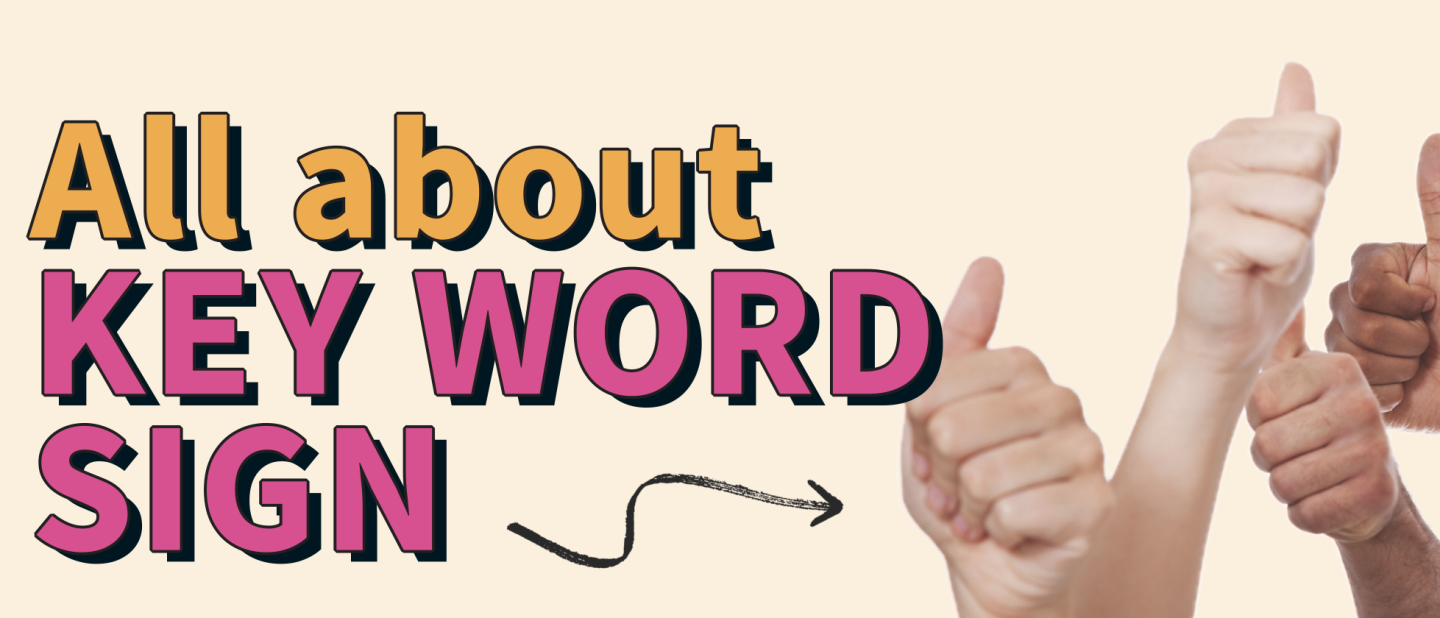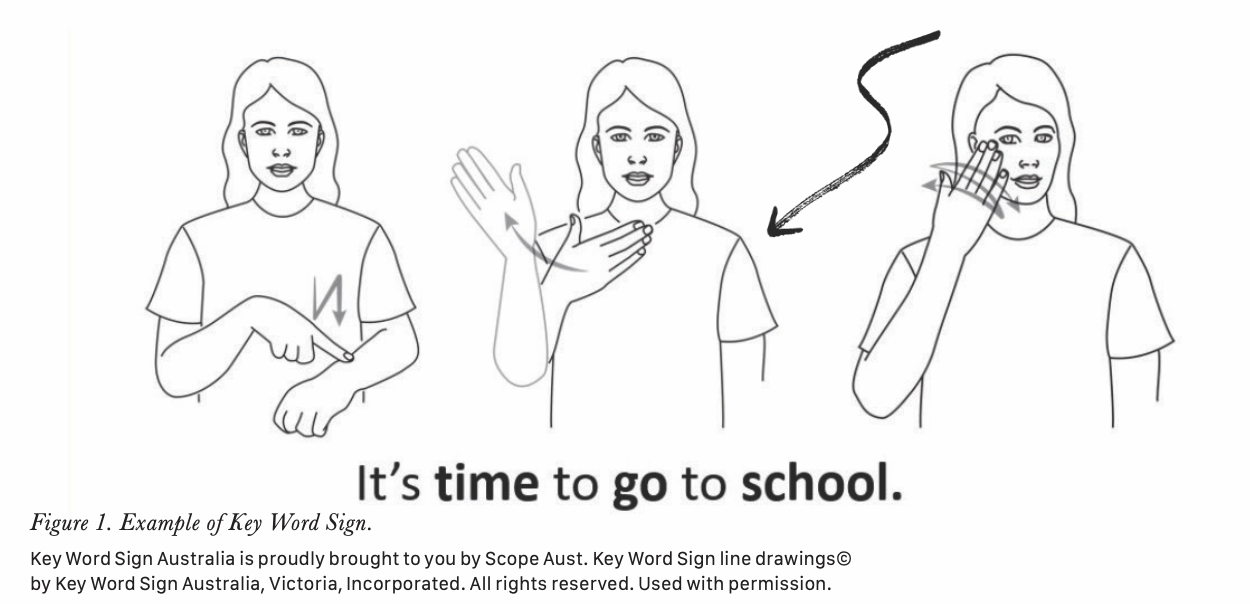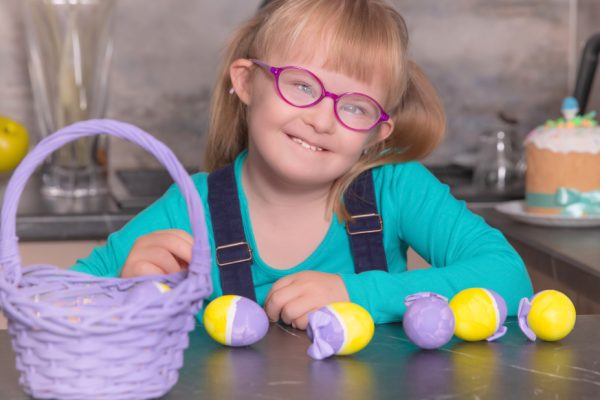
All about Key Word Sign
By Leigha Dark, Key Word Sign Australia
We all communicate in a range of ways. To share messages, understand information, form connections, and build relationships with others. We may use speech, gestures, sign language, body language, movement, eye gaze, pictures, symbols, and text.
Some children with communication difficulty or disability may need additional support to develop speech, language, and social communication skills. They may benefit from using Augmentative or Alternative Communication (AAC). Some types of AAC involve the use of communication aids, like books, boards, cards, or speech generating devices. We call this ‘Aided AAC’. Other types of AAC rely just on communication using the human body, like facial expressions, body language, gesture, and manual signs. This is called ‘Unaided AAC’. Different types of AAC can be used together to provide a person with a range of communication options that best suit them. This is a multimodal communication approach.
In this article we’re going to explore Key Word Sign, an unaided form of AAC.
WHAT IS KEY WORD SIGN?
Key Word Sign (KWS) is an unaided AAC strategy designed to help children and adults with communication difficulties to understand information and express their message to others. Speech and signs are used together. A full, grammatical sentence is spoken and signs are added to the key words. So, a person hears and sees a message at the same time. For example, in the sentence “It’s time to go to school” you might sign [time], [go] and [school] as you say the sentence. It could look like this:

HOW IS KEY WORD SIGN DIFFERENT TO SIGN LANGUAGE?
Key Word Sign is not a language. It is a communication strategy that draws attention to key spoken words, using visual signs. It is a simplified way of signing that follows spoken language word order.
Key Word Sign is used in many countries around the world and is called different things, for example in the UK it is known as Makaton. In each country, signs from the local sign language are used along with speech.
In contrast, sign languages such as Auslan (Australian Sign Language), are full and rich languages with their own unique rules for production. Sign languages are an integral part of the linguistic and cultural identity of people who are Deaf. When you learn Auslan, you are learning the language of the Deaf community of Australia.
WHO USES KEY WORD SIGN?
Key Word Sign is used by people of all ages, who experience communication disability or difficulty.
Young Children
For young children with a speech and/or language delay or disorder, key word sign can offer a means of communicating whilst speech and language skills develop. It can help facilitate the development of speech and language, and promotes social interaction skills like looking, listening, sharing and turn taking.
School-age Children
For school age children, key word sign may be used as part of a multimodal communication approach to support speech, language, social interaction, learning, participation, and inclusion. Other forms of Augmentative and Alternative Communication (AAC) such a communication books, electronic aids or visual supports may also be used.
Adults
Some adults with intellectual disability, autism, physical disability, and other sensory disabilities may continue to use KWS throughout their lives. KWS may also be used at times when a person has had a stroke or brain injury and needs access to an immediate, visual communication strategy to share needs and wants and support understanding.
Communication Partners
Whatever the age of the person using KWS as a communication method, the communication partners around that person are important.
It is vital that friends and family members learn to use KWS, to provide an accurate model of signs and to help children and adults expand their sign vocabulary. Teachers, aides and other support workers in schools and adult services also need to use KWS to model communication with signs, and to create a signing environment.
WHAT ARE THE BENEFITS OF KEY WORD SIGN?
Research shows there can be a range of benefits from using a key word sign approach to support communication. Some of these include:
Auditory and visual support for communication
Using both speech & sign when modelling means the person has opportunity to both hear and see what is being communicated.
Aids understanding
Using KWS and gesture helps us to speak slower, use shorter phrases or sentences and simplify our language.
Helps develop vocabulary and language skills
To be able to develop language skills people need to be able to use more words (increase vocabulary) and to combine them in a way that makes sense (language skills). Key Word Sign and gesture helps children and adults develop and use language in a way that doesn’t rely on speech.
Supports speech attempts
Gestures are an important part of developing communication for young children and are often used before spoken word attempts, e.g. pointing and waving. Research shows that using Key Word Sign will not stop children from speaking if that is possible for them.
Helps reduce frustration when communication breaks down
At any age, using both speech and manual signs can offer a way to clarify speech that may be unclear or unintelligible.
HOW CAN I LEARN KEY WORD SIGN?
So, are you interested in learning more about Key Word Sign? Come along to a workshop or get started with some Key Word Sign resources.
Workshops
In a Key Word Sign Basic Workshop, you will learn the principles of a key word sign approach and come away with a core vocabulary of helpful signs that you can use straight away. Delivered in a range of formats including in person, online and via eLearning, a group workshop is a great way to get started with key word sign and meet new people who are also beginning their journey. All are welcome in key word sign workshops and groups will often include a diverse mix of people including parents, family members, teachers, allied health professionals and service providers.
To learn more about Key Word Sign workshops you can visit the Key Word Sign Australia website: kwsa.org.au/training/
RESOURCES
There are many key word sign resources available to purchase or download. From books and posters to downloadable printouts and more. When selecting a key word sign resource, it is important to ensure that the signs being used with the key word sign approach are Auslan signs (Australian Sign Language). Some resources available in Australia use American Sign Language (ASL) or British Sign Language (BSL).
You can find KWS resources using Auslan signs at:
• Key Word Sign Australia – kwsa.org.au/resources
• Sign Planet – signplanet.net/
• Twinkl Australia – twinkl.com.au
• Sunshine Sign and Sing – sunshinesignandsing.com.au/
Some training and resources may be eligible for purchase on the NDIS. You can read more about key word sign and the NDIS here: kwsa.org.au/ndis






